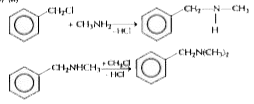Which of the following reagent is required by the following conversion?
C6H5CH2Cl→C6H5CH2−N∣CH3−CH3 Solution in Odia
CH3NH2,CH3Cl
CH3Cl,NH3
NH3,CH3Cl
CH3CH2NH2
The correct Answer is:A
Topper's Solved these Questions
- SAMPLE PAPER 1 BOOK - ARIHANT PUBLICATIONCHAPTER - SAMPLE PAPER 1 EXERCISE - GROUP A
7 Videos
- SAMPLE PAPER 1 BOOK - ARIHANT PUBLICATIONCHAPTER - SAMPLE PAPER 1 EXERCISE - GROUP B
23 Videos
- QUESTION PAPER 2019BOOK - ARIHANT PUBLICATIONCHAPTER - QUESTION PAPER 2019EXERCISE - GROUP C
11 Videos
- SAMPLE PAPER 4 BOOK - ARIHANT PUBLICATIONCHAPTER - SAMPLE PAPER 4 EXERCISE - GROUP C
7 Videos
Similar Questions
Which noble gas is used in atomic reactor ?
View SolutionBenzaldehyde can be obtained from benzal chloride. Write the reactions for obtaining benzal chloride and then benzaldehyde from it.
View SolutionWhat are oil in water and water in oil type of emulsions ? Give one example of cach type.
View SolutionConsider the reaction, Ak−−→P. The change in the concentration of A with time is shown in the following plot:

(a) Derive the expression for the time required for the completion of the reaction.
(b) Predict the order of the reaction.
View SolutionThe increasing order of reactivity of the following isomeric halides with AgNO3(H2O+alcohol) is
(I) C6H5−CH=CH−CH2−CH2−CI
(II) C6H5−CH=CH−C∣ClH−CH3
(III) C6H5−C∣CI=CH−CH2−CH3
(IV) C6H5−C6H5∣C∣Cl−CH=CH2
View SolutionWrite the IUPAC name of the following compound:
H3C−N∣CH3− CH3∣C∣ C2H5−CH2−CH3
View SolutionWhich of the following combinations give C6H5−CH3∣C∣CH2CH3−OH?
View SolutionExplain the following percentages of meta electrophilic substitutions.
(a) C6H5CH34.4%,C6H5CH2CI15.5%,C6H5CHCI233.8%,C6H5CCI364.6%
(b) C6H5N(CH3)3100%,C6H5CH2N(CH3)388%,C6H5CH2+N(CH3)319%
View SolutionThe major product of the following reaction is : C_(6)H_(5)CH_(2)-underset(Br)underset(|)overset(CH_(3))overset(|)C=CH_(2)-CH_(3)underset(C_(2)H_(5)OH)overset(C_(2)H_(5)O"N"a)to
View Solutionनिम्नलिखित में से 1∘,2∘ तथा 3∘ ऐमीन्स छाँटिए-
CH3−CH2−CH2−NH2,CH3−CH2−N∣CH3−CH3,
CH3−NH2∣CH−CH3,CH3−CH2−H∣N−CH2CH3,
C2H5−CH2−CH−CH2−CH3,
C2H5NH2,C2H5NHCH3,C2H5N(CH3)2,(C2H5)3N
View SolutionS1N तथा S2N अभिक्रिया में निम्नलिखित यौगिकों की क्रियाशीलता का क्रम कारण सहित बताइए -
(i) ब्रोमोब्यूटेन के चार समावयवी
CH2−CH2−CH2C∣BRH2, CH3−C∣BrH−CH2−CH3, (CH3)2CH−C∣BrH2, (CH3)3C−Br
(ii)C6H5CH2Br, C6H5CH(C6H5)Br, C6H5CH(CH3)Br, C6H5C(CH3)C6H5Br
View SolutionSelect the IUPAC name of the following :
H5C2−N∣CH3−CH3∣CC2H5−CH2−CH3
View SolutionWrite chemical equations for the following conversions: (i) CH_(3)CH_(2)Cl into CH_(3)CH_(2)CH_(2)NH_(2) , (ii) C_(6)H_(5)CH_(2)Cl to C_(6)H_(5)CH_(2)CH_(2)NH_(2) .
View SolutionGive the Grignard reagent and carbonyl compound that can be used to prepare
(a) CH3−CH2−CH2−OH
(b) (CH3)2C(OH)CH2CH2CH3
( c) C6H5CH2CH(OH)CH3
(d) CH3−CH2−C6H5∣C∣C6H5−CH3
View SolutionWrite chemical equations for the following conversions : CH_(3)-CH_(2)-Cl into CH_(3)-CH_(2)-CH_(2)-NH_(2) C_(6)H_(5)-CH_(2)-Cl into C_(6)H_(5)-CH_(2)-CH_(2)-NH_(2)
View SolutionThe name of CH_(3)CH(C_(6)H_(5))CH_(2)underset("OH")underset("| ")("C ")-CH_(2)CH_(3) is
View Solution

